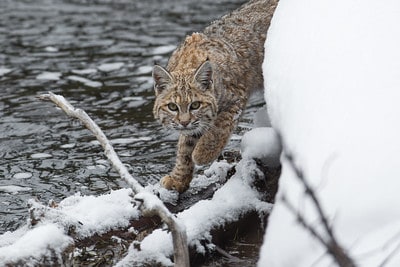If you are thinking about hunting bobcats in Montana, you have a few regulations to learn. If you are a resident, you first need to know what Trapping District you will hunt in and then start your legal search. However, if you are a nonresident, the law is simple—you cannot hunt bobcats in Montana.

Bobcat hunting season is broken into seven Trapping Districts (TD) with different dates and bag limits in Montana. In TD’s 1-3, the season runs from December 1 to February -15. In TD’s 4-7, the season runs from December 1 to March 1. Night hunting and electronic callers are prohibited.
Purchase a Montana hunting license here.
Related: Learn the rules for coyote hunting in Montana.
Related: Read this article on the three vital tips for successful bobcat hunting.
The laws for bobcat hunting in Montana.
You will be hunting only during the day.
Nonresidents may not hunt or chase bobcats.
Residents must possess a valid trappers license to hunt and chase bobcats or an RHTL (resident hound training license) to only chase bobcats.
Suppressors are legal.
Bobcat is the only animal defined by law as a furbearing animal that may be taken by hunting per MCA 87-2-601.
Hunting hours are one-half hour before sunrise to one-half hour after sunset. Bobcat chasing during the hunting season is open each day one-half hour before sunrise to one-half hour after sunset.
Bobcats may not be hunted or taken except during bobcat hunting hours.
Electronic callers are illegal. Only hand and mouth calls may be used to hunt bobcats in Montana.
Read this article and watch the video to learn how to use a closed reed rabbit squealer.
Follow along as call manufacturer Brian Rush shows you three open reed calls you can learn and use today.
Decoys are legal. You can read about some highly effective but inexpensive ($20) coyotes decoys here.
License and permits needed for hunting bobcats in Montana.
License and Permit Possession/Use (MCA 87-6-304) It is unlawful to:
• Hunt or trap or attempt to hunt or trap for any furbearing animal unless the person is carrying the required license or permit at the time.
• Refuse to produce a license or permit and the identification used in purchasing a license or permit for inspection to a game warden.
• Alter or change a license in any material manner.
• Loan or transfer any license to another person.
• Use a license issued to another person.
• Have physical control over a valid and unused hunting license or permit issued to another person while in any location that the species to be hunted may inhabit. This prohibition does not apply to a person who is carrying or has physical control over a license or permit issued to that person’s spouse or to any minor when the spouse or minor is hunting with that person.
Reporting your take of a bobcat while hunting in Georgia.
Harvest Data Reporting (CR) – Trappers and hunters must personally provide harvest registration data for bobcat, otter, marten, fisher, and swift fox when the pelt is presented to a designated FWP employee for tagging.
Reporting (CR) – Trappers and hunters are required to personally report their bobcat, fisher, marten, otter, and/or swift fox harvests within 24 hours by calling the statewide FWP reporting line at 1-877-FWP-WILD (1-877-397-9453 or 406- 444-0356) so that FWP can monitor quota levels. Trappers could also report their harvest online at fwp.mt.gov through myfwp.
Trappers are required to provide: name, telephone number, ALS number, species, date of harvest, trapping district, county, specific location (TRS or Lat/Long), and sex when reporting a furbearer harvest.
Specimen Collection (CR)
Lower Jaw – Hunters or trappers harvesting a bobcat, otter, and/or swift fox must provide a cleaned and air-dried complete lower jaw (both sides) for aging before a pelt tag is issued. Ages of harvested animals is important information used in setting harvest quotas.
Before bringing in the lower jaw, remove as much flesh as possible and allow it to dry in the open air. To prevent decay, do not store or transport in any closed container made of plastic—use a paper bag or cardboard box. The jaw may be returned upon request.
Kill Site Verification (ARM 12.6.1005) – As a condition of hunting and trapping in Montana, persons may be required to return to the kill site or trap site if requested to do so by a FWP warden.
Using electronic callers to hunt furbearers in Montana.
It is unlawful to use any recorded or electrically amplified bird or animal calls or sounds or imitations of bird or animal calls or sounds to assist in the hunting, taking, killing, or capturing of any wildlife except predatory animals, wolves, and those birds not protected by state or federal law.
Permission needed from property owners for hunting bobcats in Montana.
Landowner Permission (MCA 87-6-415) – A person may not hunt or attempt to hunt furbearers, game animals, migratory game birds, nongame wildlife, predatory animals, upland game birds, or wolves while hunting on private property without first obtaining permission of the landowner, the lessee, or their agents.
Regardless of whether the land is posted or not, hunters must have permission from the landowner, lessee, or their agent before hunting on private property. For the purposes of this section, the term “hunt” has the same meaning as provided in 87-6-101 and includes entering private land to: (a) retrieve wildlife; or (b) access public land to hunt.
Areas closed to hunting bobcats in Montana.
The bobcat season on the Flathead Indian Reservation is closed.

